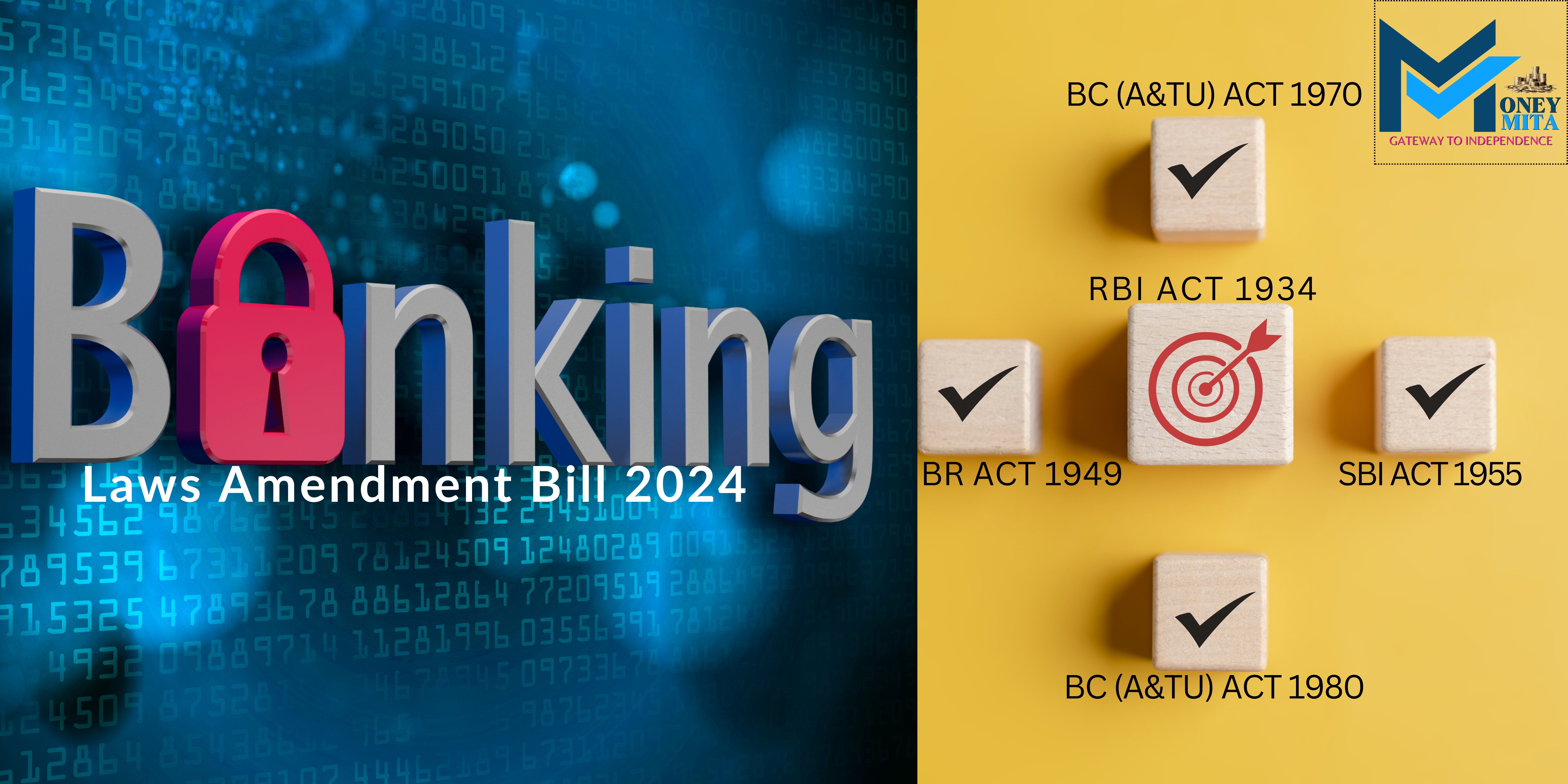Table of Contents
ToggleThe Banking Laws Amendment Bill 2024
The Banking Laws Amendment Bill, 2024′ a Revamp in Banking was first introduced as part of the Union Budget 2023-24.
Later, Finance Minister Nirmala Sitharaman introduced the bill in the Lok Sabha on August 9, 2024. It was passed by voice vote on December 3, 2024, during the Winter Session of Parliament.
Honourable Finance Minister Nirmala Sitharaman aimed at improving bank governance and enhancing investor protection. This bill seeks to modernise banking regulations by amending Five (5) existing laws with Nineteen (19) amendments.
The five laws where amendments are being made are as follows:-
- The Reserve Bank of India (RBI) Act, 1934
- The Banking Regulation (BR) Act, 1949
- The State Bank of India (SBI) Act,1955
- The Banking Companies (Acquisition and Transfer of Undertakings) Act, 1970 [BC(A&TU) Act 1970]
- The Banking Companies (Acquisition and Transfer of Undertakings) Act, 1980 [BC(A&TU) Act 1980]
SOURCE:- https://egazette.gov.in/WriteReadData/2024/256241.pdf
The notable amendments under five laws are classified into four (4) following categories.
1. Improved Liquidity, Asset Management And Consistent reporting By Banks.
2. Enhance The Governance Standards Of Banks.
3. Elevate The Protection & Convenience Of Depositors By Banks.
4. Management of Unclaimed Money By Banks.
The 2024 Amendment Bill-Improved Liquidity, Asset Management And Consistent Reporting By Banks
RBI proactively addresses liquidity challenges by the populated tool of Cash Reserve Ratio(CRR) and statutory Liquid Ratio(SLR).
As the name implies, a certain amount is to be kept as reserve in the form of CRR and SLR by banks to the central bank(RBI) for depositors’ protection as well as to protect the liquidity affairs of banks. CRR percentage is changed occasionally by the RBI to bring monetary stability to the country.
KEY AMENDMENTS
Revised “Timeframe” for CRR, SLR Calculation, Asset maintenance and consistency in reporting by timely submission of statutory returns in case of
- Scheduled Banks as per RBI Act 1934
- Non – Scheduled Banks as per Banking Regulation Act 1949
REVISED TIME FRAME :-CRR Calculation & Returns By Banks
CRR = A reserve maintained as a specific percentage of demand and time liabilities in India, as reported by banks in statutory returns submitted to the RBI.
TABLE – 1
| PARTICULARS | SCHEDULED BANKS | NON-SCHEDULED BANKS | NON-SCHEDULED CO-OPERATIVE BANKS |
| CRR:- Demand and time liabilities are based on | Average daily balance at the close of each business day of a fortnight. | Last day of the second preceding fortnight. | Same as Col 3. |
| Frequency of compliance | Fortnightly | Monthly | Monthly |
| Due date of Return | Not later than Five(5) days from the close of business on the last day of each fortnight. i.e, – for the 1st to 15th of a month, the due date is the 20th of the respective month. | Before the 20th day of every month. i.e., – for April, the due date is within 20th April. | Before the 15th day of every month. i.e., – for April, the due date is within 15th April. |
| Contents of return | Seven (7) types of information like demand and time liabilities, amount of its borrowings from banks in India, legal tender notes and coins held by it etc are a few of them. | Demand and time liabilities as held on the last day of the fortnight. | Same as Col 3. |
| FORTNIGHT (Pre-amendment) | The period from Saturday to the second following Friday (both days inclusive) | Same as Col 2 | Same as Col 2. |
| FORTNIGHT (Post-amendment) | 1) 1st to the 15th day of each calendar month OR 2) 16th to the last day of the calendar month 3)Opening and closing days are inclusive in both cases). | Same as Col 2 | Same as Col 2 |
| Scope | Section 42(1) & (2) of the RBI Act 1934 | Section 18 of the BR Act 1949 | Section 56 of the BR Act 1949 |
NOTES:-
- Geographical Limitations
a) Banks facing operational challenges can send a provisional fortnightly return, followed by the final return within 20 days after the fortnight’s end.
b) Alternatively, a provisional monthly return can be sent within 20 days of the month’s end, replacing the fortnightly returns. - This amendment ensures that the period for calculating the CRR is based on calendar months rather than the traditional Saturday-to-Friday cycle, regardless of the day of the week the period begins.
REVISED TIME FRAME:-SLR Calculation, Asset Management & Returns By Banks
Statutory Liquid Ratio(SLR) is an “Additional Reserve – Fortnightly” over and above CRR, has to be kept with the central bank(RBI) and to be reported via returns.
Maintenance of “Assets Benchmark” =Banking companies in India have to maintain an “Asset Benchmark – Quarterly” for reporting to the RBI.
Amendments:- Definition of “Fortnight” – Refer to “TABLE 1″ above
TABLE – 2
| PARTICULARS | SLR – AN ADDITIONAL RESERVE | MAINTENANCE OF ASSETS IN INDIA | SELF – ASSESSMENT RETURNS BY BANKS |
| A) Asset Coverage Benchmark | Assets must be <=40% of demand & time liabilities in India as on the last day of the second preceding “FORTNIGHT” after the close of business. | Assets must be >=75% of demand and time liabilities in India as on the last day of each “QUARTER” after the close of business. N . A | N . A |
| Frequency of compliance | Monthly Return | Quarterly Return | Monthly Return |
| Timeline for Returns to RBI | Within 20 days from the end of each month, i.e,- say for April, the due date is “within 20th May” | Within the next 1 month from the end of each quarter, i.e,- say for the June quarter, the due date is “within July ” | Within the next 1 month from the end of each month. i.e, – say for April, the due date is “within May” |
| Contents and Aim of the Return | CONTENTS 1. a) Assets coverage as per the “1st Row” above and b) Demand and time liabilities in India as on the last day of each “FORTNIGHT” after the close of business. AIM:- The liquidity capability of a bank can be evaluated based on this return. | CONTENTS 1. a) Assets coverage as per the “1st Row” above and b) Demand and time liabilities in India as on the last day of the previous “QUARTER” after the close of business. AIM:- Assets must be sufficient to back liabilities. | CONTENTS 1. a) No cut-off rate of assets maintained to be reported here. b) Assets and liabilities of the bank in India as on the last day of “Each Month” after the close of business. AIM:- The financial health of a bank can be evaluated based on this return |
| Penalty for Non – compliance in maintaining prescribed % of SLR | 1) 3% p.a above the bank rate for the first default. 2) 5% p.a above the bank rate for consecutive defaults. 3) If shortfalls persist for continued default, responsible officials (directors, managers, secretaries) may face fines for wilful default of ₹500/- per default, increasing with each fortnightly breach. | N. A | N. A |
| Scope | Section 24 of the BR Act 1949 | Section 25 of the BR Act 1949 | Section 27 of the BR Act 1949 |
NOTES:-
1 . For TABLE (1 and 2 ) above:- If the last day of the “fortnight” or “Month” or “Quarter” is a public holiday as per Negotiable Instrument Act 1881, the reserve is calculated based on the close of the preceding working day.
2 . “Quarter” means “Three (3) months” ending on the last day of “MARCH”, “JUNE”, “SEPTEMBER” and “DECEMBER” in a year.
The 2024 Amendment Bill-Enhance The Governance Standards Of Banks
Governance standards in banks refer to the principles and practices ensuring accountability, transparency, risk management, and ethical conduct in banking operations. Enhancing governance standards brings good governance in the management of resources and decision-making to achieve sustainable development and the well-being of all stakeholders.
Amendments – “Governance Standards”
- Redefinition of “Substantial Interest”
- Extended “Tenure of Office by Directors” in Co-operative Banks
- Remuneration of Auditors in Banks
Redefinition of Substantial Interest
An individual has a “Substantial Interest” in a company if they, alone or jointly with their spouse or minor child, hold the lower of the following:
- Paid-up value of shares worth Rupees Two Crores (₹2 crores) or more (revised from ₹5 lakhs).
- 10% of the company’s total paid-up capital of the company.
SCOPE:- This amendment is as per Section 5(ne) of the Banking Regulation Act 1949.
Interpretation:
The increase in monetary threshold [from ₹5 lakhs to ₹2 crores] for determining substantial interest, reflects inflation and the growth of business scales since the earlier limit was set decades ago. It ensures that only significant stakeholders are categorized under this definition, aligning regulations with current economic realities.
EXAMPLE
1. If the paid-up capital of a company is Rs. 25 crores,10% of it comes as Rs. 2.5 crores. Here the threshold of Rs. 2 crores will apply.
2. But if the up capital of a company is Rs. 10 crores,10% of it comes as Rs.1 crore here the threshold of Rs. 1 crore will apply.
Extended Tenure of Office for Directors in Co-operative Banks
SCOPE :- Sections 10(2A)(i) and 16(3) of The BR Act 1949’
New Rule for Cooperative Bank Directors:- Maximum tenure extended to 10 years (from 8 years).
Exception: This restriction does not apply to the Chairman or Whole-time Director of a Co-operative banking company.
Prohibition of Common Directors
Rule Overview (16(1)):– A person cannot be a director in two banking companies simultaneously.
Existing Exception:- RBI-appointed directors are allowed to serve in multiple banking companies.
New Exception Introduced:- If a director of a Central Cooperative Bank becomes a member of a State Cooperative Bank and is elected by all members as a director on the state bank’s board, they are exempt from the restriction on common directorship, resulting in appointment in multiple banking companies will be allowed.
These changes aim to balance governance flexibility with oversight for cooperative banks.
Remuneration of Auditors in Banks
SCOPE
Uniform amendments regarding appointment and remuneration of auditors across all three acts as below.
- Section 41 of The SBI Act 1955
- Section 10 of Banking Companies (Acquisition & Transfer of Undertakings) Act,1970 and 1980.
Appointment of Auditors:
Auditors must be qualified as per Section 141 of the Companies Act, 2013 to get appointed.
Remuneration of Auditors:
- Old Provision: RBI fixed the remuneration in consultation with the Central Government.
- Amendments: “State Bank of India or the corresponding new bank acquired”, itself through its board of directors approval will determine the remuneration of auditors.
The 2024 Amendment Bill-Elevate Protection & Convenience Of Depositors By Banks
Banks in India are custodian of
- Deposit of money in short-term or long-term instruments of depositor/s
- Articles kept by a holder/s
- Jewellery, valuables and legal documents kept in a locker taken on hire by depositor/s
All banks allow depositors to nominate any person of their choice , be it minor or major .
Nomination arises on the demise of the depositor. Nomination ensures rightful claim to assets, reducing disputes and delays.
Earlier only “ONE PERSON” was allowed as nominee which showed its pitfalls during the COVID-19 pandemic, where survival was a big challenge. Both the depositor’s and single nominee’s deaths caused serious hardships to families where assets couldn’t be retrieved due to single nomination. The new amendment deals with this issue.
New Rule Of “NOMINATION” For “Deposits & Others”
Key Change: Maximum of 4 nominees allowed (previously 1) in all three cases above.
TABLE -3
| PARTICULARS | Nomination for “Depositor’s Funds with a Banking Company” | Nomination for “Articles held by a Banking Company” | Nomination for “Items stored in a Bank Locker” |
| Scope of Amendment | Section 45ZA of the BR Act 1949 | Section 45ZC of the BR Act 1949 | Section 45ZE of the BR Act 1949 |
| Applicability | The depositor’s money in full is to be nominated. | Articles left in the bank’s custody | Locker contents. |
| Types of Nomination | Successive or Simultaneous as per the wish of depositor/s. | Successive only. | Successive only. |
Rules of Successive or Simultaneous are within the scope of newly inserted section 45ZG of thr BR Act 1949.
Successive Nomination
- Nomination is effective in priority order (e.g., Nominee A → B → C).
- Subsequent nominees step in only upon the death of the preceding nominee.
- Default order applies if no explicit priority is mentioned.
Example:– Say Mr X nominates A, B, and C successively for Rs. 1 crore, On X’s death, A receives 100%- Rs. 1 crore. If A dies, B receives 100% — followed by C 100%, — when B also dies.
Simultaneous Nomination
- Nominees share “specified proportions of the deposit”.
- If a nominee dies, their share is treated as if no nomination was made for it.
Example: For the same deposit, if X nominates A with 70%, B with 20% and C with 10% shares, then Rs. 1 crore will be distributed as specified unless a nominee dies before getting the nominated amount from the banking company.
Say- If A dies, the 70% nomination is treated as if no nomination was made. The act is not very clear regarding the nominee’s death timing (before or after the depositor’s demise), and treatment of the dead nominee’s share among other nominees, which leaves a scope for reamendment as in my personal opinion.
The 2024 Amendment Bill-Management of Unclaimed Money By Banks
Key Takeaways
Uniform amendments regarding the transfer of unpaid or unclaimed money by the “SBI” or “the corresponding new bank” as the case may be, to the Investor Education And Protection Fund (IEPF) established under section 125 of the Companies Act 2013, in all three acts as below
SCOPE OF AMENDMENT
- Section 38A of The SBI Act 1955
- Section 10B of Banking Companies (Acquisition & Transfer of Undertakings) Act,1970 and 1980
The amendment concerns the following categories of unpaid/unclaimed money:-
- Unpaid/Unclaimed Dividends : Money in the “Unpaid dividend account” has been unpaid or unclaimed for 7 years since its transfer to the respective bank’s above account.
- Shares with Unpaid/Unclaimed Dividend : Shares of banks for which dividends have not been paid or claimed for 7 consecutive years along with statements containing details.
- Unclaimed Interest or Redemption Amount of Bond : Interest or redemption money on bonds issued by banks unpaid/unclaimed for 7 years since it is due for payment.
Claim by Individuals:
Individuals whose shares or unclaimed or unpaid money was transferred to the Investor Education and Protection Fund are entitled to claim transfer or refunds from the said fund as per provisions of sections 124 and 125 of the Companies Act 2013.
FREQUENTLY ASKED QUESTIONS
Q1 . What is a scheduled Bank?
Ans. A Bank which is included in the Second Schedule as depicted by section 2(e) of the RBI Act 1934. Ex – Bank of Baroda, Deutsche Bank A.D, HDFC Bank Limited etc.
Q2 . What does the Banking Companies (Acquisition & Transfer of Undertaking) Act 1970 deal with ?
Ans. The Banking Companies (Acquisition and Transfer of Undertakings) Act, of 1970, regulates the nationalization of 14 major banks on July 19, 1969. It focuses on managing and expanding these banks across India, regulating their paid-up capital, replacing private banks with public-sector ones, removing their limited company status, and supporting their business operations.
Q3 . What does the Banking Companies (Acquisition & Transfer of Undertaking) Act 1980 deal with ?
Ans. The Banking Companies (Acquisition and Transfer of Undertakings) Act, of 1980 facilitated the nationalization of six (6) more banks to extend banking services to a larger population. It aimed to strengthen public sector banking, improve credit accessibility, and promote balanced economic development across the country.
Q4 . What is the “Bank rate”?
Ans. The bank rate is the interest rate at which the Reserve Bank of India (RBI) lends money to commercial banks. A tool by RBI to control inflation in the country. Directly proportional to inflation increase – i.e., if inflation increases, RBI increases bank rate and vice versa.
Q5 . What is the dividend in a company?
Ans. On earning profits, a fraction of profit is distributed among shareholders based on their proportion of holding.
Q6 . How is a Bond defined in a company?
Ans. A form of debt security issued by the company to raise funds for specific purposes. Bonds are fixed income-bearing instruments.
Q7 . What is the Redemption of Bond in a company?
Ans. On maturity, the principal amount of the bond is repaid to bondholders/lenders by the borrower or issuer of the bonds.








